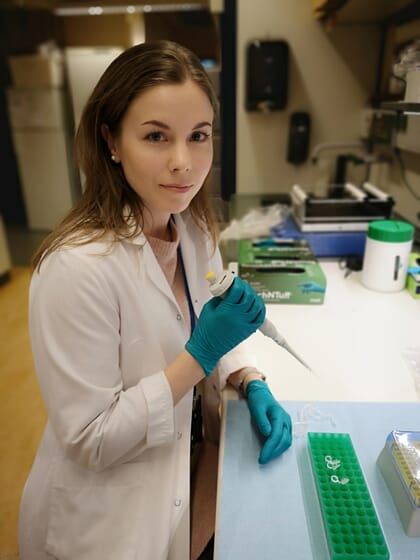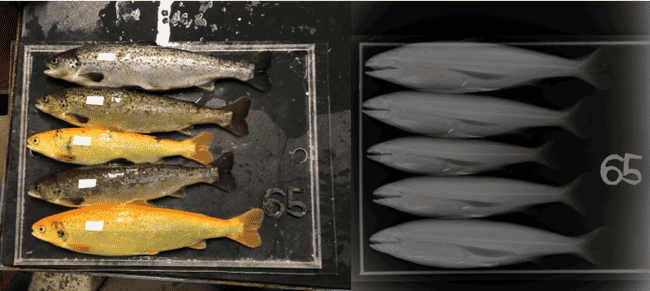Lene Kleppe of Norway's Institute of Marine Research (IMR) presented the results of the project at the ARCH-UK-organised International Finfish Sterility Workshop, which took place in Edinburgh on 26-27 March.
An earlier study by Kleppe’s research group, led by Anna Wargelius, had showed that it was possible to render salmon sterile using CRISPR-Cas9 technology to knock out a gene essential for germ cell development.

“What we found was that actually not a single [edited] fish showed any signs of puberty, while more than half of the control males were fully mature at two years of age and 30 percent of the female controls had started to enter puberty. So, this was very promising,” she said.
However, the group wanted to follow up on this, so launched a new project in 2017 to investigate the performance of 432 salmon through their whole life cycle, in order to assess growth and a number of welfare indicators. In order to achieve this the knock-out fish were also rendered albino using the same technology.
The growth has been measured at regular intervals between the start of the experiment in November 2017, with the most recent measurement being taken in January 2019.
“There is some difference from the beginning in both groups of fish – the knock-out fish are a little bit smaller than the controls. But as the fish get older, these differences are not significant anymore. And this [trial] is ongoing, so we will see what happens as they grow even bigger,” Kleppe explained.
The specific growth rates are also encouraging.
“The dead-end knock-out fish look a little bit small at the beginning [of the trial] but they have a normal growth rate. And some groups of knock-outs have a higher growth rate than the controls. So it could look like they are compensating for their small size as they grow bigger,” she explained.
And she also mentioned her “theory” that it might the pigmentation of the fish that is impacting their growth early in life.
“Maybe the fish are compensating with higher growth rates, and we are wondering if these differences that we see can be caused by albinism instead of the knock-outs. So, we are looking into that now, we have some extra experiments. We are looking at albinos vs normally pigmented fish, to see if we can see any differences in growth. And my impression is that this is the case,” she emphasized.
They also looked at smoltification capacity, using qPCRs to measure the sodium/potassium ATPase activity in the gills, which is important for smoltification capacity in fish.
“Overall, it seems like the knock-out fish are doing just as good as the controls,” Kleppe noted.
The researchers are also looking into biochemical welfare markers in the plasma – such as lactate, Na+, Cl-, osmolality and pH levels – to assess if there was a difference in the stress response or if there were any difficulties with osmoregulation. Some differences were found in levels of lactate and osmolality, however these were temporary. The majority of the fish in the trial smoltified, but more analyses, she noted, are needed before it’s possible to conclude whether smoltification is more stressful for the knock-outs.

© Lene Kleppe, IMR
As for organ indexes for the post-smolts?
“As we expected, we see some difference in the gonado-somatic index. Knock-out fish don’t have germ cells, so we expect that they would have smaller gonads. But we don’t see any difference in the cardio-somatic index, or hepato-somatic index. Maybe there is a trend here, but there is no significant difference, at least at this point,” she said.
“And I wanted to mention that we are looking at skeletal deformities – we have done x-rays on all of the fish twice now, one time in freshwater, and one time in seawater. These images haven’t been analysed yet, but I have looked through them all. And with my untrained eye, at least, I cannot see any irregular fish. There are no differences between the groups as far as I can see. So that’s promising,” she continued.
“To sum up: when it comes to growth, we see some differences early in life that seem to level out,” she explained.
And welfare markers?
“The sodium/potassium ATPase activity looks normal, we might see some temporary affect in the plasma for some welfare markers. But skeletal deformities are, to my knowledge, not different between groups,” Kleppe said.
And she also stressed that the project is due to run for at least another year.
“But of course, this is ongoing. We are still looking at growth, we will study puberty, we are looking at vertebrae strength, mineral content and we are doing a gene expression study on these fish. We have selected several tissues and we will do RNA sequencing to see if we can find any differences between these groups of fish. So this is the status today,” she concluded.
Acknowledgments
The International Finfish Sterility Workshop, which was sponsored by AquaGen, was supported by the Salmotrip project, which has been running for the last four years and was co-funded by BBSRC, Innovate UK, Mowi, BioMar and Pharmaq.



